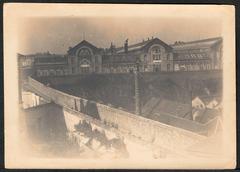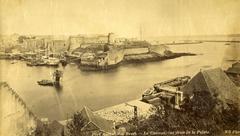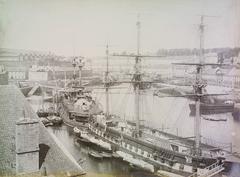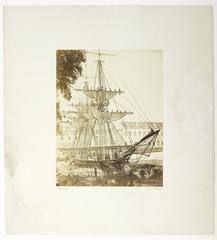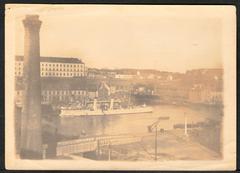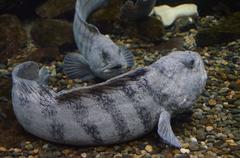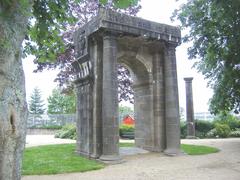
Visiting the Botanical Conservatory of Brest, France: Guide, Tickets, Hours, and Tips
Date: 04/07/2025
Introduction: History and Significance
Nestled in the lush Stang-Alar Valley on the outskirts of Brest, Brittany, the Botanical Conservatory of Brest (Conservatoire Botanique National de Brest) is a renowned destination for plant lovers, conservationists, and travelers. Established in 1975 in response to the growing global concern for biodiversity loss, the conservatory has become a pivotal center for ex-situ plant conservation, scientific research, and environmental education. With a living collection of over 1,700 species—including many rare and endangered plants from Brittany, the Atlantic islands, and diverse ecosystems worldwide—the conservatory stands as a guardian of global plant heritage and a model for sustainable garden design.
Visitors to the conservatory enjoy immersive walks through extensive outdoor gardens, themed zones such as alpine rock gardens and medicinal plant displays, and the acclaimed tropical greenhouses that replicate humid and arid climates. The site’s unique microclimate and environmentally conscious architecture further enrich the visitor experience. Beyond its botanical collections, the conservatory is a hub of research, education, and community outreach, partnering with universities and conservation organizations to foster biodiversity awareness and preserve plant genetic resources.
Whether you are a botany enthusiast, planning a family outing, or seeking cultural exploration, this guide offers essential information on visiting hours, ticketing, accessibility, and nearby Brest historical sites. For updates, guided tours, and special events, visit the official Botanical Conservatory of Brest website, France Guide, or Try Travel.
Table of Contents
- Origins and Early Development
- Growth, Recognition, and Status
- Visitor Information: Hours, Tickets, and Tours
- Unique Features and Visitor Highlights
- Conservation and Scientific Contributions
- Regional and Global Importance
- Nearby Brest Historical Sites
- Visitor FAQs
- Cultural and Scientific Importance
- Thematic Gardens and Living Collections
- Practical Visitor Information
- Accessibility, Facilities, and Sustainability
- Visitor Experience: Activities and Events
- Visuals and Additional Resources
- Conclusion and Recommendations
- References
Origins and Early Development
Founded in 1975, the Botanical Conservatory of Brest was established by botanist Jean-Yves Lesouëf and local conservationists to address the urgent need for plant protection. The Stang-Alar Valley, with its sheltered microclimate, was transformed from a neglected quarry into a sanctuary for threatened flora (franceguide.info). Initially, the conservatory focused on the preservation of Brittany’s native plants and later expanded to include species from France and around the globe.
Growth, Recognition, and Status
The conservatory quickly gained momentum, constructing specialized greenhouses to house temperate and subtropical plants by the 1980s. In 1990, it was formally designated a “Conservatoire Botanique National,” earning national recognition for its scientific expertise and conservation leadership. Today, its 47 hectares span from the valley to the Moulin Blanc beach, encompassing public parks, thematic gardens, and extensive greenhouses (franceguide.info).
Visitor Information: Hours, Tickets, and Tours
Opening Hours
- Tuesday to Sunday: 9:00 AM – 6:00 PM (extended to 8:00 PM in summer)
- Closed Mondays and major public holidays
Tickets and Admission
- Outdoor gardens: Free entry
- Tropical greenhouses: Small admission fee (varies seasonally; check official website)
- Guided tours and workshops: Additional fee; book online or at the entrance
- Children under 12: Free
- Group and reduced rates available
Visitor Services
- Guided tours in French and English (weekends and by appointment)
- Audio guides and interactive maps
- Wheelchair-accessible paths and facilities
- On-site café, picnic areas, and gift shop
Access and Directions
- Address: Stang-Alar Valley, Brest, Finistère, Brittany, France
- Easily accessible by car (on-site parking) and public transport
Unique Features and Visitor Highlights
- Diverse Living Collections: Over 1,700 species, including plants extinct in the wild such as Hibiscus insularis and Sophora toromiro
- Thematic Gardens: Alpine rock gardens, regional flora zones, medicinal plant displays, and more
- Tropical Greenhouses: 1,000 m² of rare orchids, rainforest species, dryland succulents, and endangered island flora
- Scenic Trails: Landscaped paths with interpretive signage and panoramic viewpoints
- Special Events: Annual plant festivals, photography workshops, and seasonal exhibitions
- Virtual Tours: Online resources and interactive maps for remote exploration
Conservation and Scientific Contributions
Recognized internationally, the conservatory leads in ex-situ conservation, maintaining a seed bank and collaborating with universities and conservation networks. Its research supports plant propagation, genetic diversity, and habitat restoration, influencing regional and global biodiversity strategies (try-travel.com; cbnbrest.fr).
Regional and Global Importance
The conservatory protects Brittany’s unique flora, advises on habitat management, and supports local and international conservation initiatives. Its data and expertise inform biodiversity policy, invasive species control, and climate adaptation efforts in France and beyond (cbnbrest.fr).
Nearby Brest Historical Sites
Enhance your visit with these cultural and historical sites:
- Château de Brest: Historic fortress and maritime museum
- Recouvrance District: Traditional Breton architecture
- Océanopolis: Marine park highlighting local sea life
- Pont de Recouvrance: Iconic lift bridge
- National Maritime Museum: Insights into Brest’s naval heritage
For travel tips and directions, consult the official tourism page.
Visitor FAQs
Q: What are the opening hours?
A: Open Tuesday–Sunday, 9:00 AM–6:00 PM (8:00 PM in summer), closed Mondays and public holidays.
Q: Are tickets required?
A: Entry to outdoor gardens is free; tropical greenhouses and tours require a ticket.
Q: Is the conservatory accessible?
A: Fully accessible for wheelchairs and strollers, with adapted paths and facilities.
Q: Are pets allowed?
A: Only service animals are permitted.
Q: How do I book a guided tour?
A: Book online via the official website or at the entrance.
Cultural and Scientific Importance
Conservation and Research Hub
The conservatory is a leader in ex-situ plant conservation, managing over 1,700 species and participating in global conservation networks. Its activities include seed banking, plant propagation, and reintroduction of endangered flora (try-travel.com).
Education and Outreach
Educational programs, workshops, and guided tours engage visitors of all ages. Digital tools like the eCalluna app and the scientific journal E.R.I.C.A. provide interactive learning opportunities.
Cultural Landscape
The conservatory integrates Breton cultural elements into its gardens and hosts art exhibitions, concerts, and seasonal festivals, enriching Brest’s community life (try-travel.com).
Digital Innovation
With digital field guides, open-data catalogues, and citizen science initiatives, the conservatory remains at the forefront of modern botanical engagement (cbnbrest.fr).
Partnerships and Recognition
Collaborating with institutions such as Université de Bretagne occidentale, Région Bretagne, and international botanical networks, the conservatory is a founding member of the French Federation of Botanical Gardens (finistere.fr, brest.fr).
Thematic Gardens and Living Collections
Outdoor Gardens: Regional flora, endangered species, alpine and rock gardens, wetland and aquatic zones, and medicinal plants (nomads-travel-guide.com).
Tropical Greenhouses: Rainforest, island, and desert plants—including many extinct-in-the-wild species (cbnbrest.fr).
Must-See Attractions: Belvedere viewpoint, rare plant displays, seasonal blooms, and family-friendly areas.
Practical Visitor Information
- Reception Pavilion: Maps, brochures, and multilingual staff available
- Amenities: Accessible restrooms, picnic areas, gift shop, and water fountains
- Food: Limited on-site; nearby cafés in Stang-Alar and central Brest
- Transport: Local buses from central Brest; ample on-site parking
For updated hours, ticketing, and event details, visit the official website.
Accessibility, Facilities, and Sustainability
The conservatory is fully accessible, with paved paths and adapted restrooms. Sustainability is central, with eco-friendly buildings, green roofs, straw insulation, and rainwater harvesting (batinfo.com).
Visitor Experience: Activities and Events
- Expert-Led Tours: Regular guided walks and workshops in French and English
- Family Activities: Safe, open spaces and interactive displays
- Annual Events: Fête des Plantes on May 1st, photography contests, and themed exhibitions (nomads-travel-guide.com)
- Community Engagement: Volunteer opportunities and citizen science projects
Visuals and Additional Resources
High-quality images, interactive maps, and virtual tours are available via the official conservatory website. For reviews and tips, see Nomads Travel Guide.
Conclusion and Recommendations
The Botanical Conservatory of Brest is a must-see for nature enthusiasts, families, and anyone interested in conservation or cultural heritage. Its blend of botanical diversity, scientific innovation, and visitor-friendly amenities ensures a memorable and educational experience. Combine your visit with a tour of nearby Brest historical sites for a comprehensive cultural journey.
Plan your visit today via the official website, download the Audiala app for maps and event notifications, and follow the conservatory on social media for the latest news.
References
- This guide draws on information from the Official Website, France Guide - Brest, Try Travel, Batinfo, Audiala, and Nomads Travel Guide.


